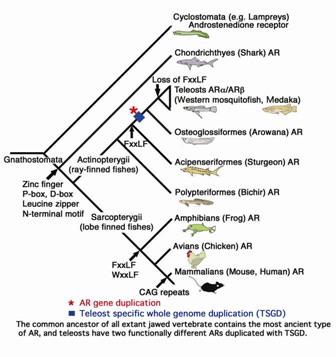
Ogino Y, Katoh H, Kuraku S, Yamada G. (2009) Evolutionary history and functional characterization of androgen receptor genes in jawed vertebrates. Endocrinology 150(12):5415-5427.
Vertebrates show diverse sexual characters in sexually attractive and reproductive organs , which are regulated by steroid hormones, particularly androgens. However the evolutionary history of Androgen receptor ( AR ) gene remains largely unknown on the basis of phylogenic and functional analyses. To elucidate the evolutionary history and functional diversification of AR genes in vertebrates, we cloned the AR cDNAs from a shark, basal ray-finned fish es (Actinopterygii), namely bichir and sturgeon (Acipenseriformes), and teleost s including a basal teleost, arowana (Osteoglossiformes). Molecular phylogenetic analysis revealed that the gene duplication event that gave rise to two different teleost AR s ( α and β ) likely occurred in the actinopterygian lineage leading to teleost s after the divergence of Acipenseriformes but before the split of Osteoglossiformes, which is compatible with the phylogenetic timing of teleost-specific genome duplication (TSGD) . Searching for AR genes in the medaka genome indicated that the teleost AR gene duplication has been associated with the duplication between chromosomes 10 and 14. Our functional analysis revealed that the shark AR activates the target gene via androgen response element (ARE) by classical androgens. The teleost ARα showed the unique intracellular localization with a significantly higher transactivating capacity than that by teleost ARβ . These findings indicate that the most ancient type of AR, as activated by the classical androgens as ligands, emerged before the Chondrichthyes-Osteichthyes split, and the AR gene was duplicated during the TSGD event. We report here for the first time the accurate evolutionary history of AR gene and functional characterization of ARduplicates in teleost lineage.
